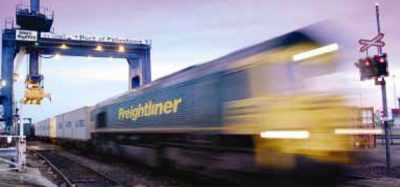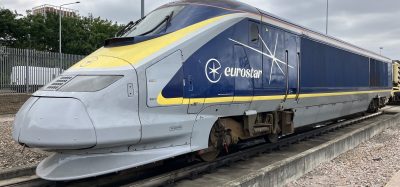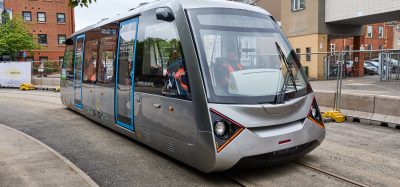SJ’s communication installation
Posted: 14 February 2006 | | No comments yet
The X 2000 is one of SJ’s leading trains. Compared with other means of transportation it offers its passengers the possibility to use their travel time to work or be entertained. To extend this advantage, SJ have started to develop a system for seamless communication. It has two purposes: the possibility to use cell phones and to surf the Internet.
The X 2000 is one of SJ’s leading trains. Compared with other means of transportation it offers its passengers the possibility to use their travel time to work or be entertained. To extend this advantage, SJ have started to develop a system for seamless communication. It has two purposes: the possibility to use cell phones and to surf the Internet.
The X 2000 is one of SJ’s leading trains. Compared with other means of transportation it offers its passengers the possibility to use their travel time to work or be entertained. To extend this advantage, SJ have started to develop a system for seamless communication. It has two purposes: the possibility to use cell phones and to surf the Internet.
SJ have made two huge investments during the last couple of years; the renovation of the 15 year old X 2000 trains and the purchase of the new double-decker X 40 trains. The X 2000 is Sweden’s first modern high-speed train and is mostly used for longer inter-regional travel. It was introduced in 1990 and was ready for both interior and exterior improvements. The new X 40 train is a modern high-speed train with two floors, primarily designed for heavy commuting traffic.
To make the trains even more attractive, besides other modernisations, they are being equipped with seamless communication for the possibility to make cell phone calls and surf the Internet onboard. Creating the system faced a number of difficulties. The trains travel long distances through very sparsely populated areas, as well as passing through tunnels and parts of northern Sweden where satellite reception is adversely affected. These are some of the problems we had to solve.
Modern trains are almost hermetically sealed metal boxes, making it hard for any radiation to get in or out. Even the windows are covered with a thin metal film (which actually makes it easier to speak on the cell phone on an older train, since their windows are not covered with film). That makes it almost impossible to make a call from the X 2000 train when it is moving. But SJ was the first train company in the world to solve this problem by introducing one system for the mobile phones and one for the Internet.
When dialling from the cell phone a ‘leak-cable’ in the roof of the train car picks up the signal and ‘leaks’ it out of the car. The same kind of cable is often used in mines, tunnels or large building complexes. By using a cable with the same function the government authority Banverket, who is responsible for the infrastructure of the railway in Sweden, have been working together with a number of operators to ensure a good reception in the tunnels. Banverket functions as a project leader and the different operators pose requests on which tunnels they would like to work on and pay for the instalment. To begin, the highest priority is given to the distances between Sweden’s three biggest cities; Stockholm, Gothenburg and Malmö.
The ‘leak-cable’ can be used for one-way and two-way communication, and thanks to its broadband capability, from under 900 MHz to 2.65 GHz, it can handle multiple communication systems simultaneously. Outside the car, the radio signal faces other problems. The train is partly going through vast, uninhabited areas and to amplify the signal a repeater is installed in each car.
Every repeater contains different cards for the different phone networks; three different phone operators are part of one GSM-card – the 3G operator has its own card as well as the government authority Banverket, but the public cannot use these. Banverket operates its own MobiSir network, also called GSMR and is right below GSM 900 in frequency. Most employees of Banverket have their own MobiSir-telephones and will be able to call from the train. Since the phone operators are the ones making money on the commuters’ calls, they pay the costs for the cards.
The repeaters are in turn connected to a shark fin-like antenna on the roof of the train car. It is a multi-band antenna handling everything from GSM 900 and GSM 1800 to UMTS and GPS.
We ran into one unexpected problem during the installation of the mobile system. If the doors are open the ‘leak cable’ is not able to pick up signals from outside, diverting the repeater. That causes instability in the system. Together with the different operators and Banverket we worked on isolating the external and the internal antenna. The solution turned out to be the placement of the external antenna. Now we have a good enough isolation between the two antenna systems to live up to the high demands of the different parties involved. The system is not one hundred per cent perfect, in some parts of Sweden the train simply is too far from a transmitter. During 2006 we aim for it to be up and running in all X 2000 and X 40 trains.
There is no point entering the discussion on the possible risks of radiation from cell phones, since it is still too indistinct, but we can establish that with this system it gets lower. A cell phone has the highest signal when searching. In the closed confinements of a train car it always works with the strongest output. With the help of our system it instead works on the lowest signal level.
Making sure it is possible to surf the Internet partly works on the same system but was even trickier. It demanded a moving antenna, cooperation of several operators and satellite communication.
When the user switches on a computer, a wireless network in each train car makes sure the user can log in to the wireless network. The transmitter then passes the signal to a local server, which in turn is linked to a number of different antennas and a satellite dish on the roof.
There are three different choices for Internet connection; the server constantly chooses the fastest. Either the communication goes through GSM (512 Kbit/second per train). The second alternative is the 3G net, which is like an ADSL (1.5 Mbit/second per train). Besides that the server communicates via satellite to receive information; usually when you are on the net the need to receive information is greater than the need to send. The satellite communication works at a rate of total 4 Mbit per second per train.
Since the speed is affected by a number of circumstances, number of users and number of accessible links, it is hard to more than estimate the performance. The capacity is more than sufficient for common tasks such as sending e-mails, connecting to a company network via VPN and accessing ordinary web pages. A revolving satellite dish on the train roof constantly searches the alternative connections and the server chooses the fastest. To withstand the wind while travelling at 200 kilometres per hour, the satellite dish is surrounded by a glass bowl.
The further north you travel, the fewer accessible alternatives exist. The mobile networks have not got full coverage of the area and the satellite is hard to access. When travelling in northern Sweden, the satellite dishes point almost vertically. Most satellites are stationed above the equator and considering the earth’s angle, makes it hard to collect the signals. So far this is not a real problem for SJ since traffic in the most northerly regions of Sweden is limited.
To use the Internet, the passenger needs a laptop computer with a wireless LAN card. When trying to access the Internet the browser is redirected to the onboard SJ page. After typing the code received on the ticket, or bought in the bistro, a new window is opened and you are ready to surf the web. The SJ onboard page also shows information about the service, a map shows the current position of the train and there are banners for other SJ offerings. Today, all X 2000 trains in operation are equipped with the Internet system.
Installing seamless communication is just part of the general modernisation of the X 2000 fleet. All 43 trains will have a new exterior, cleaned from all colours and stripes –only sporting grey steel and the logo in a chrome-like finish. Inside, the cars are rebuilt with new chairs, colours, lighting, wooden panels and an all new bistro. All seats have been equipped with electric sockets, drink-holders and hangers. The renovation has been performed with a high level of environmental consideration. Among other actions taken, all the chairs have been recycled and re-upholstered, instead of being thrown away. All the material used is also chosen with consideration to the environmental aspects. The bistro received an all new look with more space and bright red sofas. Along with the aesthetic changes we engaged the association Chef of the year to help us compose a new menu and assortment. Today you can chose between six different kinds of coffee, a range of fine wines and food from the season’s menu.
At the beginning of 2006 we have renovated 12 of our X 2000s. Our aim is to complete all the trains during 2007.
The 43 new double-decker trains are being received from the manufacturer Alstom and will be gradually put into operation. Just like the renovated X 2000, the double-decker is all grey with only the logo in a chrome-like finish. Inside, it is very similar to that of the X 2000, with a mixture of bright wood, light greys and browns – giving a Nordic touch to the interior. For extra comfort the double-decker also has electric sockets by every seat, hangers and drink-holders. There is no room for a bistro on board, but vending and coffee machines are available. We aim for all the trains to be in service by the end of 2006.
The Internet has been up and running in all X 2000s since the autumn of 2005. During the first months it was free to try. Today it is included in the First Class fare and passengers in Second Class pay approximately €5 for 30 minutes, and €11 for unlimited access throughout the entire journey. So far it has been running flawlessly and we have received excellent feedback from our passengers. As soon as the system has been installed in all X 40 trains, we can evaluate the system and eventually go on to develop it. Being able to e-mail and surf the Internet makes the time on the train more valuable. We are already discussing new alternatives and solutions. If we can add further services to the offers we provide then we can make the train even stronger in competition with car, bus and air travel.







